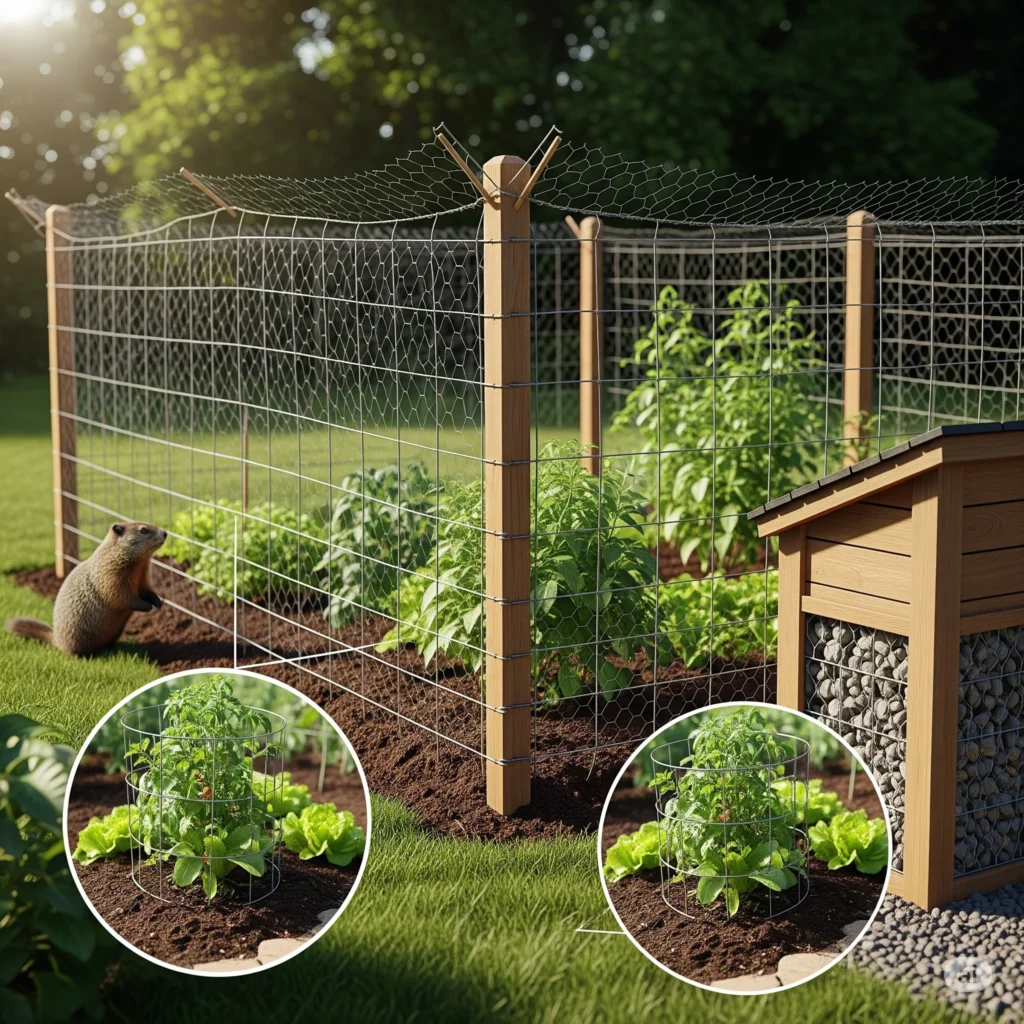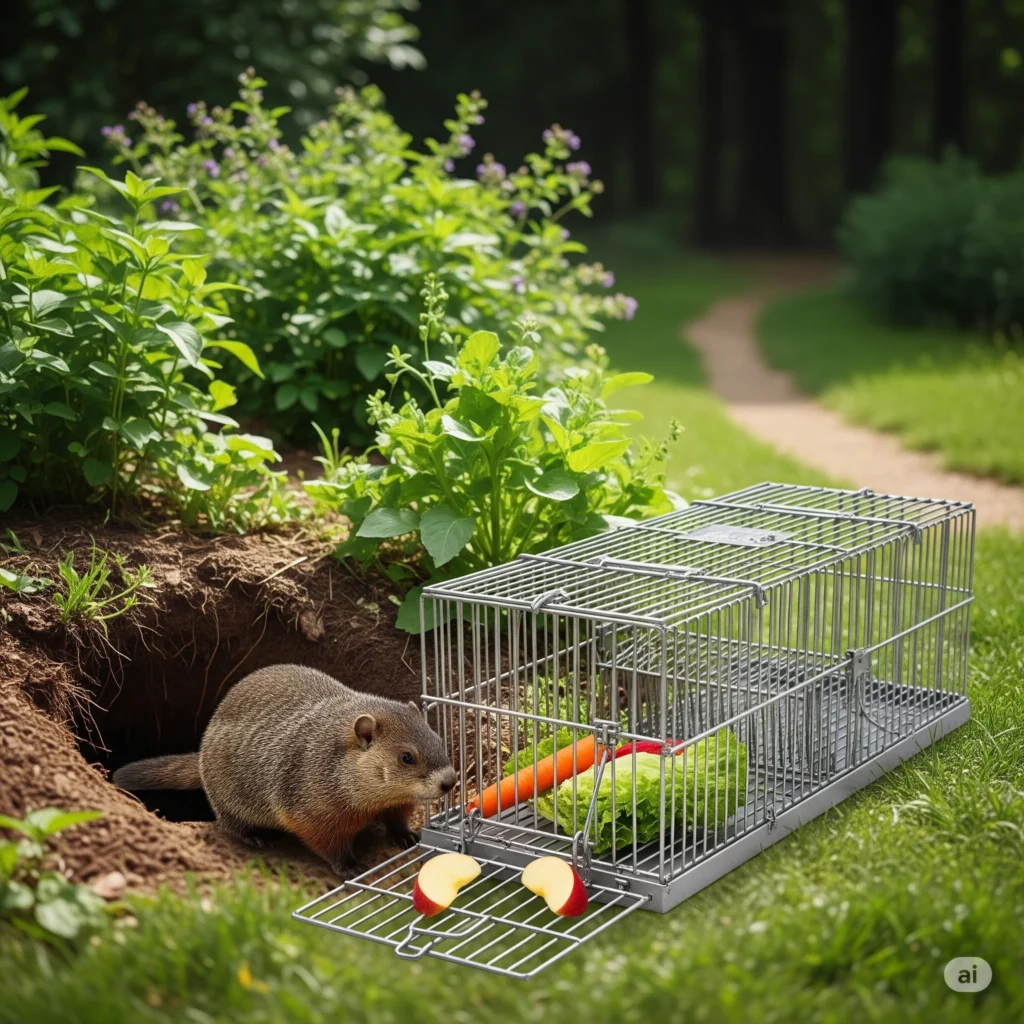Groundhogs, also called woodchucks, may look harmless, but they can cause a lot of damage to your garden. If you’ve spotted a groundhog in your yard or noticed groundhog holes in your yard, you’re probably wondering how to keep groundhogs out of garden without harmful methods. This guide offers simple, natural, and humane solutions to protect your plants and maintain a thriving garden. From effective groundhog repellents to sturdy barriers, these practical tips will help you achieve natural groundhog control and keep your garden safe and beautiful.
Understanding Groundhogs: Why They Target Gardens
Groundhogs are burrowing rodents attracted to areas with abundant food and shelter. Your garden, filled with vegetables, flowers, and soft soil, is an ideal spot for them. They particularly prefer crops like lettuce, carrots, and beans, making a groundhog in your garden a threat to your harvest.
These animals create deep burrows, often leaving groundhog holes in your yard or under structures like sheds or decks. If you’re wondering how to get rid of groundhogs under a house or shed, understanding their behavior is key. Groundhogs are active during the day, typically in the early morning or late afternoon, and hibernate during winter. This knowledge helps you plan effective strategies for how to keep groundhogs out of garden.
What draws groundhogs? Food, shelter, and easy access. Let’s explore natural and humane ways to implement groundhog deterrents and protect your garden.
Effective Groundhog Repellents: Natural Solutions

One of the simplest ways to achieve natural groundhog control is by using repellents. Many gardeners ask, “What smells do groundhogs hate?” The answer lies in strong, unpleasant odors and tastes. Here are proven homemade groundhog repellent recipes:
Cayenne Pepper Spray
Groundhogs dislike spicy scents. A homemade spray made from cayenne pepper or hot sauce can act as a powerful deterrent. Here’s how to prepare it:
- Mix 2 tablespoons of cayenne pepper or hot sauce with 1 gallon of water.
- Add a few drops of dish soap to help the spray adhere to plants.
- Apply to plants and around garden borders.
This safe, natural groundhog deterrent protects your plants and pets while repelling groundhogs. Reapply after rain to maintain its effectiveness.
Garlic and Onion Mixture
Garlic is another odor groundhogs avoid. Blend a few garlic cloves with water, strain the liquid, and spray it around your garden. Alternatively, scatter chopped onions or garlic near plants for added protection. These affordable ingredients are excellent for getting rid of groundhogs naturally.
Epsom Salt
Sprinkling Epsom salt around garden beds repels groundhogs due to its bitter taste. It also benefits plants as a fertilizer, making it a dual-purpose solution. Reapply after heavy rain to keep it effective.
Vinegar as a Repellent
Some ask, “Will vinegar get rid of groundhogs?” While vinegar’s sharp smell may temporarily deter groundhogs, it’s less effective than pepper or garlic sprays. To try it, soak rags in white vinegar and place them near groundhog holes or garden entry points. For best results, combine vinegar with other repellents.
These natural methods are ideal for those seeking how to keep groundhogs out of garden while being kind to the environment and wildlife.
Build a Groundhog-Proof Fence: Physical Barriers

For reliable groundhog deterrents, physical barriers are highly effective. Groundhogs are skilled diggers, so barriers must be robust and strategically designed. Here’s how to protect your garden from groundhogs:
Install Durable Fencing
To keep groundhogs out, set up a fence at least 3-4 feet tall and buried 12-18 inches underground to prevent digging. Use chicken wire or hardware cloth for strength. Bend the top outward to make climbing difficult. This is particularly useful for raised beds or small garden areas.
Seal Entry Points
If groundhogs are burrowing under your house or shed, sealing entry points is essential. Inspect for gaps around foundations and fill them with gravel, concrete, or wire mesh to block access to these sheltered spots.
Protect Individual Plants
For smaller gardens or specific crops, use wire cages or netting around plants. This is a quick solution for how to keep groundhogs out of garden without fencing the entire area.
Combining physical barriers with natural repellents creates a garden that groundhogs find unappealing and hard to access.
Humane Removal Tips: Trapping and Relocation

If repellents and barriers aren’t enough, humane trapping offers another way to achieve natural groundhog control. Here’s how to do it responsibly:
Select an Appropriate Trap
Use a live trap, such as a Havahart trap, sized for groundhogs (about 32 inches long). Place it near groundhog holes in your yard or along their paths.
Bait the Trap
Groundhogs are attracted to fresh vegetables like lettuce, carrots, or apples. Place bait inside the trap and check it daily to avoid stressing the animal.
Relocate Safely
Before trapping, review local regulations, as some areas restrict wildlife relocation. Release the groundhog 5-10 miles away in a suitable habitat, like a wooded area, to prevent its return.
Humane trapping is a compassionate approach for those looking to protect their garden from groundhogs without causing harm.
Preventing Groundhog Damage: Long-Term Strategies

To ensure lasting groundhog deterrents, focus on prevention. Here’s how to make your yard less inviting:
Eliminate Attractants
Groundhogs are drawn to food and hiding places. Keep your yard tidy by:
- Removing brush piles and tall grass.
- Harvesting ripe vegetables promptly.
- Securing compost bins to avoid tempting groundhogs.
Modify the Habitat
Make your yard less appealing by filling groundhog holes with gravel or dirt. Plant crops groundhogs avoid, such as herbs or marigolds, to discourage them.
Use Motion-Activated Devices
Motion-activated sprinklers or ultrasonic devices can startle groundhogs and keep them away. These are effective tools for how to keep groundhogs out of garden with minimal effort.
These strategies help maintain a garden that groundhogs steer clear of over time.
Conclusion: Safeguard Your Garden Naturally
Learning how to keep groundhogs out of garden is straightforward with the right approach. By using effective groundhog repellents, building sturdy barriers, and practicing humane removal, you can protect your plants and maintain a beautiful garden. Whether you’re dealing with a groundhog in your yard, under a shed, or digging holes, these natural solutions will help you achieve groundhog control.
Start with simple steps like homemade repellents and fencing, and consider trapping if necessary. With a bit of effort, you’ll enjoy a groundhog-free garden. Try these tips today and share them with fellow gardeners to keep everyone’s plants safe!
Frequently Asked Questions About Groundhog Control
How can I get rid of groundhogs quickly?
Combine cayenne spray, fencing, and humane traps. Check traps daily and reapply repellents regularly for fast results.
What are the best groundhog repellents?
Strong odors like cayenne, garlic, and Epsom salt are highly effective. Buried fences also work well as physical deterrents.
How do I stop groundhogs under a shed or house?
Seal gaps with wire mesh or gravel and apply garlic spray nearby. Trapping may be needed for persistent issues.
What smells do groundhogs dislike most?
They avoid spicy scents, garlic, and motion-activated devices. Secure fencing also deters them effectively.



